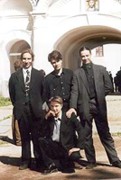Russki Lad
 The early music ensemble Russkiy Lad was organized in St Petersburg in 1999. The group consists of 9 members, all of who have secondary or higher education in music. All our members are singers of various Orthodox churches of St Petersburg. The aim of the group is to familiarise the general public with the history and treasures of Russian Spiritual music and liturgic chant. Our repertory includes Orthodox liturgic chants from the earliest period (XII century) to contemporaneity (modern spiritual compositions and harmonisations).
The early music ensemble Russkiy Lad was organized in St Petersburg in 1999. The group consists of 9 members, all of who have secondary or higher education in music. All our members are singers of various Orthodox churches of St Petersburg. The aim of the group is to familiarise the general public with the history and treasures of Russian Spiritual music and liturgic chant. Our repertory includes Orthodox liturgic chants from the earliest period (XII century) to contemporaneity (modern spiritual compositions and harmonisations).  Compared to European countries, Russia converted to Christianity relatively late: the citizens of Kiev were baptised in 988 (although according to the annals, a Christian congregation was known to exist in Kiev already in the IX century). Together with the new faith, Russia also adopted its already complex system of religious service, borrowed from the Byzantine tradition. This included liturgic chant. It took several hundred years (approximately until the XIV century) for Christianity to take root and for liturgic chant to be adapted to Russian settings. In the course of this, the chant became known in Russian as znamenniy. It was this type of monodic chant that remained predominant in the Russian church until the XVI century. Due to its domination during at least four centuries, the znamenniy chant came to embody the entire variety of Russian liturgy, being adapted to express the full yearly cycle of religious service: for instance, the All-Night Vigil alone can include up to 54 different compositions.
Compared to European countries, Russia converted to Christianity relatively late: the citizens of Kiev were baptised in 988 (although according to the annals, a Christian congregation was known to exist in Kiev already in the IX century). Together with the new faith, Russia also adopted its already complex system of religious service, borrowed from the Byzantine tradition. This included liturgic chant. It took several hundred years (approximately until the XIV century) for Christianity to take root and for liturgic chant to be adapted to Russian settings. In the course of this, the chant became known in Russian as znamenniy. It was this type of monodic chant that remained predominant in the Russian church until the XVI century. Due to its domination during at least four centuries, the znamenniy chant came to embody the entire variety of Russian liturgy, being adapted to express the full yearly cycle of religious service: for instance, the All-Night Vigil alone can include up to 54 different compositions. Starting from the XIV century, references to other, different modes of chant (yet still monodic) start appearing in the annals (demestvenniy, putyevoi). By XVIII century we find a multitude of both monodic (the above plus Greek and Bulgarian chants, as well as the compositions of individual authors) and polyphonic chant (three-part putyevoi chant, two- and three-part znamenniy chant). Subsequently Russia also receives influences from the Polish partes tradition and the Little-Russian samolovka harmonization of ancient chants, with a third added to the main melody and a lower voice supporting the main melodys as a changing bourdon.
In modern times, the last century of study devoted to early liturgic chant has resulted in a renewal of the use of early chant. The members of the group Russkiy Lad sing regularly in the Monastery of Valaam (Boris Sorokin - 2nd chorusmaster), Optinaya Pustynya (Alexandr Bordak - singer), and Konyev (Dmitri Fountussov - chorusmaster) - places where all types and modes of early chant have traditionally been used in liturgical service. We will perform compositions from these early chants in our concert.



